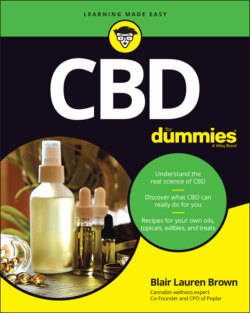Читать книгу CBD For Dummies - Blair Lauren Brown - Страница 78
Relieving pain and physical ailments
ОглавлениеPromising research indicates that CBD can reduce inflammation and chronic pain, which is one of the contributors to the opioid epidemic. Additionally, patients are unlikely to build up a tolerance to CBD; that means they don’t have to increase dosages to maintain effects (another issue with opioids).
CBD affects a variety of enzymes throughout the body, including in the skin. For example, it suppresses the production of TNF-a, a pro-inflammatory enzyme found throughout the body, including the skin. CBD also promotes two receptors responsible for anti-inflammatory effects: TRPV-1, or vanilloid, and PPAR-y, or gamma.
A doctor once told me in passing at a conference that CBD is already known to interact with over 76 different receptors in the body. Whoa!
The vanilloid receptor itself is responsible for decreasing the intensity of pain signals and the overall nervous system’s response to pain. Acute pain is caused by physical trauma of some sort, whether it has a known cause (like a shin bang or broken bone) or unknown cause (like a migraine or backache). For surface-level acute pain, you can use topical CBD treatments; for more severe acute pain, particularly internal, ingestible CBD is a better choice. Regardless of the pain type, you want to choose a CBD medium with a rapid onset so you don’t have to wait around for relief.
Transdermal patches are starting to fill that gap in the topical space because they offer internal relief with a topical treatment (head to Chapter 1 for more on transdermal treatment). Otherwise, the fastest onset is inhalation or sublingual (under the tongue) tinctures. Doses for pain should be higher than supplemental doses, and you can use them until the pain is alleviated without worrying about becoming dependent.
Chronic physical pain can sometimes have a neurological component when the pain has persisted over a long time and may have a historical association with psychological or physiological trauma. The nerves can signal pain even when no physical reason for it actually exists. Theories and early studies indicate that a controlled amount of THC is the most significant relief opportunity in cannabis for this kind of pain. The current legal limit for THC in full-spectrum CBD is 0.3 percent, which just may not be enough for that kind of pain experience. But everybody is different, and giving CBD a try for such pain may still help. High doses of full-spectrum CBD and maybe even broad-spectrum or isolate may work for some because inflammation is often still at the core of many pain problems. (Chapter 4 has details on full- and broad-spectrum CBD and isolate.)
Arthritis patients are seeing deeper relief with topical applications. With the overwhelming lack of scientific studies and clinical trials available, people who are experiencing a lack of relief from traditional options are trying CBD as a remedy and finding results. The Arthritis Foundation conducted a poll of its community and discovered that 29 percent currently use CBD in a liquid or topical form and reported improvement in physical pain, stiffness, and function.
